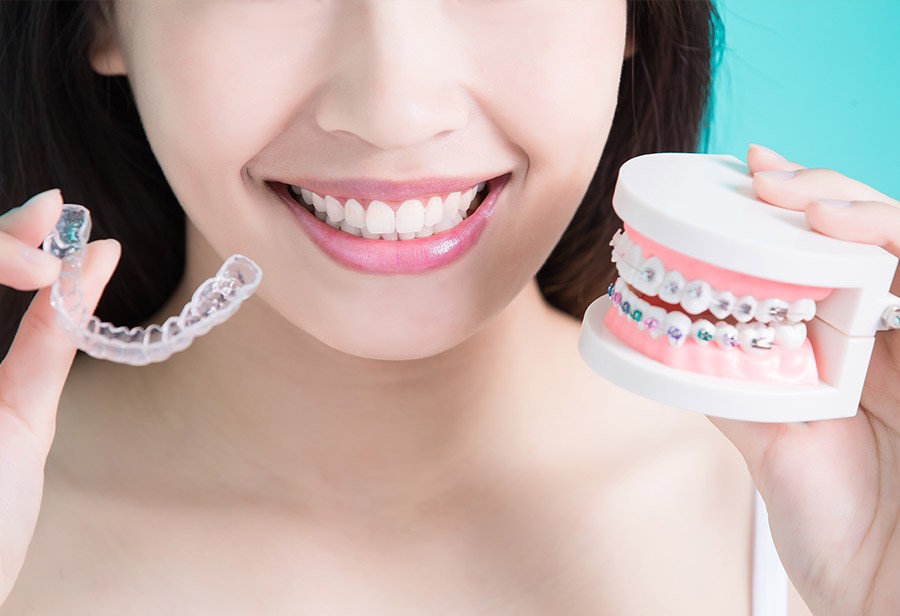2021 Guide to Invisalign vs. Braces
The decision between Invisalign versus braces is something you might have to face as a parent. While they have their differences, they're both used to treat malocclusions.
What's a Malocclusion?
"Malocclusion" is a word that can sound like a mouthful, but in plain English what it means is someone in your family has a mouth full of problems. These issues can include:
- Crooked teeth
- Crowded teeth
- An overbite
- An underbite
Treating Malocclusions
Treating a variety of malocclusions helps patients enjoy straighter teeth, more confidence, better smiles, and improved oral health. Invisalign and conventional braces are common options. Both prove effective for many malocclusions, but they're not identical.
Braces
Traditional metal braces are brackets that are glued to the patient's teeth. They are then tied together using tiny rubber bands and wires.
Invisalign
Invisalign is a specific brand name of clear braces or clear aligners. These are smooth plastic used to fit over the teeth and are far less visible. Invisalign still requires in-office visits, even though some clear aligner choices are 'at-home' treatments.
Primary Differences of Invisalign Versus Braces
The materials they are made out of are just the first of many differences in cases of Invisalign vs. braces. They also have differences in regards to appearance, comfort, costs, effectiveness, follow-up visits, maintenance, and treatment time.
Appearance
Braces
Conventional metal braces can't be removed by the patient. They're also very visible. Both of these are downsides to people who are self-conscious about how they look, although it doesn't bother everyone.
Invisalign
The clear plastic composition makes Invisalign treatment almost invisible. Patients can also remove them quickly if they want a natural smile when having a picture taken.
Comfort
Braces
Traditional braces might produce discomfort and pressure that is similar to teeth moving on their own. They also have the potential for irritation of the gums and cheeks due to rubbing, although most drug stores have an orthodontic wax that can address this.
Invisalign
Invisalign is designed to avoid physical discomfort outside of the slight pain and pressures involved with teeth being properly repositioned.
Costs
Braces
The costs involved with conventional braces depends on various factors. These include market locations and pricing and also the difficulty involved with the treatment. Without any insurance coverage, braces run anywhere from $1,800 up to $5,500 overall.
Invisalign
Invisalign is only an in-office treatment, so it's more expensive than at-home clearn aligners that might run between $2,000 to $3,000. Expect Invisalign to cost $3,000 up to $8,000 without dental insurance, but also count on it proving more effective than at-home alternatives.
Effectiveness
Braces
Braces are known to be effective in the straightening of just about any kind of malocclusion issue with misaligned teeth. This is a big reason why braces have been used for so long and so many patients. However, they're not always effective for patients who regularly participate in rough contact sports.
Invisalign
Invisalign works just as well as braces for most patients suffering from a malocclusion. However, clear aligners aren't as great for patients with:
- Bridges
- Issues with back teeth biting
- Teeth that need to move vertically
- Not enough motivation to keep their aligners in for 22 or more hours per day
- Canines or premolars that need rotation
Follow-Up Visits
Braces
Conventional metal braces require constant adjusting. This usually means patients need an in-office visit every one to two months.
Invisalign
Invisalign patients get several sets of their aligners at the same time. These are changed every two weeks, so professional visits only happen in roughly six-week intervals.
Maintenance
Braces
If your child wears braces, then you need to make sure they brush their teeth following every meal. Failing to do so can leave food particles left stuck in the wire or brackets, resulting in teeth staining and inferior oral hygiene. You might also need to buy special flossing tools for cleaning in hard-to-reach spots.
Invisalign
Patients with Invisalign can clean them simply by brushing them and even running them under slightly warm water. Otherwise, oral hygiene is just the usual matter of normal brushing and flossing of teeth.
Treatment Time
Braces
Traditional braces that are followed be retainers can take anywhere from 18 months to three years to finish the treatment regimen.
Invisalign
Based on how complicated the treatment is and how well the patient complies with their instructions, Invisalign might run from six up to 18 months.
In Conclusion
Invisalign and braces can each be effective means of correcting the alignment of your teeth or the teeth of your children. Before you make a decision between the two, contact My Dentist in Los Angeles to learn more about both of these options.
By accepting you will be accessing a service provided by a third-party external to https://www.mydentistinlosangeles.com/

